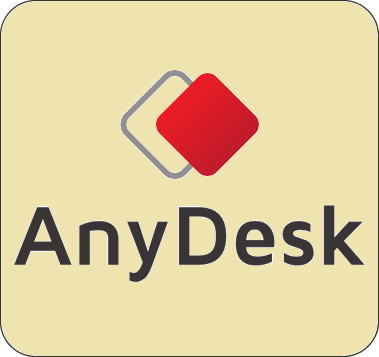Access sleeping or shutdown Windows, macOS, and Linux devices using Wake-On-LAN.
Allows you to view your desktop from any desk. This is a program that is ideal for those who use the same computer or who are working together on files or while viewing websites. You can access your desktop. AnyDesk offers maximum flexibility adapting to your security or policy requirements.
Requirements
- At least one more AnyDesk device in the local network must be online.
- Wake-On-LAN is enabled in the AnyDesk settings.
Wake-On-LAN Settings

- Disabled: Deactivates Wake-On-LAN in AnyDesk.
- Enabled: Activated by default. Using this option, AnyDesk will automatically ping random AnyDesk clients on the same direct local area network as the device to be woken up and request them to send a wake-up packet to the target device.
- Enabled, but wake your device using the following desks only: AnyDesk ID(s) from devices in the local network can be set up here. The device can only be woken up, as long as one of the devices in the list is online.
Wake from Sleep Mode
AnyDesk wakes devices set to Sleep Mode, given that at least one device running AnyDesk is available in the local network of the incoming client.
Wake from Shutdown
Wake on LAN for devices that are shutdown:
- Shutdown (S5 Power State, default for Windows 7)
- Hybrid shutdown (Default for Win 8, 8.1, 10)
is available when the network-adapter is configured for Wake-On-LAN in the BIOS/UEFI.
Disclaimer: All changes to your system are made without guarantee and at your own risk.
- Enter BIOS Settings at the startup of your PC (usually by pressing Del or F1)
- Find Power Management menu and Wake-On-LAN option there
- Enable Wake-On-LAN
- Enable Wake-On-LAN in your OS:
- For Windows 7/10:
- Open Start menu
- Search for “Device Manager”
- Expand the “Network Adapters” section
- Right mouse click on the network card and go to Properties
- Select Tab 'Advanced'
- Scroll down in the list to find “Wake on Magic Packet”
- Change the value to “Enabled”
- Click the Power Management tab
- Set “Allow this device to wake the computer” and “Only allow a magic packet to wake the computer” to enabled
- Click OK
- Deactivate fast startup
- Open Settings
- System
- Power & Sleep
- Additional power settings
- Choose 'what the power buttons do'
- Uncheck the option 'Turn on fast startup'
- For macOS:
- Launch System Preferences
- Click on 'Energy Saver' located at the second row of icons
- For laptops: Select 'Power Adapter' tab, check 'Wake for Wi-Fi network access' box (your Wi-Fi router needs to support this feature)
- For desktops: Towards the center of window under Computer sleep and Display sleep sliders, check the 'Wake for Network access' box.
- For Windows 7/10:
- Wake-over-Wifi needs the same setup in the BIOS/UEFI and a Wifi Router that supports it.
Advantages of using Wake-On-LAN
- energy consumption
- general availability
Anydesk Program
- The power consumption is reduced while your device is still accessible.
- When set up, your devices always remain accessible at any time.

In our series about unconventional use cases, we have already talked about the creation of artificial limbs (https://blog.anydesk.com/how-anydesk-helps-shining-3ds-customers-create-artificial-limbs/) and new software (https://blog.anydesk.com/coding-together-with-anydesk/). From these examples, it may seem that AnyDesk is only beneficial in highly-skilled fields where people need to work together or remotely control their complex projects.
Today, we want to show you that operating AnyDesk is easy for everyone, and it can even serve to teach people all kinds of new skills and help innovative individuals to craft new technologies. By combining the many features AnyDesk has for collaborative work, it can easily be used as a tutorial tool.
First of all: Did you know that AnyDesk has a Whiteboard feature? It’s perfect for giving clear instructions. The tools AnyDesk offers for successful tutorial sessions aren’t advanced features by any means: They all come with the free 3mb file you can download without having to install or sign up to anything.
Now let’s say you want to learn about video editing.
You already found the perfect software and a teacher who is very skilled and willing to share their knowledge, but they live on the other side of the globe. The only thing that stands between you and your dream of becoming a video editor is distance. Thankfully, you both have AnyDesk. By connecting remotely, it’s like your tutor is looking over your shoulder while you try out your video editing software.
Chat
You can efficiently communicate using the chat box. Imagine your instructor tells you via chat to layer your video files in order to get the 2 clips to fade into each other. Sounds easy enough! But when you try it, they just won’t layer. Typically, you would have to take a screenshot, send it to your tutor and have them text you back telling you to take another screenshot, because there’s an area they can’t see, etc.
With AnyDesk, your instructor has already watched you make your mistake in real time. Chances are they’ve already told you what you should have done via the chat function.
Whiteboard
With 16 colors and multiple drawing modes, the range of AnyDesk’s On-Screen Whiteboard tools exceed that of any real-life whiteboard.
Let’s change roles in our hypothetical and say you’re the teacher. You could use the cursor to point to the right settings in the video editing software. If you tap it, the other side can see it in the form of a small circle popping up. Granted, you could also just change the settings yourself, but ideally you want your student to learn where to find them.
You can also draw freehand or create lines, rectangles, or even arrows to point to items of emphasis.
Using multiple tracks and files of both audio and video can become confusing in video editing and drawing instructions on screen is much easier than just texting confusing directions to your student.
An interesting feature of the Whiteboard is that you can layer elements, allowing you to draw simple Venn diagrams or double-highlight certain parts to ensure your instructions are clear at all times.
Operating the Whiteboard is very intuitive. You simply click and hold in order to create an element. A right mouse click is like putting down your brush and returning to a normal cursor. To delete an element, use the clear or clear-all button on the Whiteboard toolbar (they are the ones that look like erasers).
Session Recordings
Any Anydesk Player
Automatic Session Recordings are helpful for tutors and trainees alike. If you’re learning, you can watch the lesson repeated whenever you need to look something up. As an instructor, re-watching the lesson helps you improve your tutorials. And if anything is still unclear, you can both go back and work on the problem together.
What Is Anydesk
As soon as you’re a video editing pro, you can offer lessons via AnyDesk yourself. Imagine if multiple people wanted to receive video editing lessons from you. You could acquire an AnyDesk license and teach them at the same time in the form of a remote online presentation. You could even charge them a small amount of money and earn some additional income without ever leaving the house!
